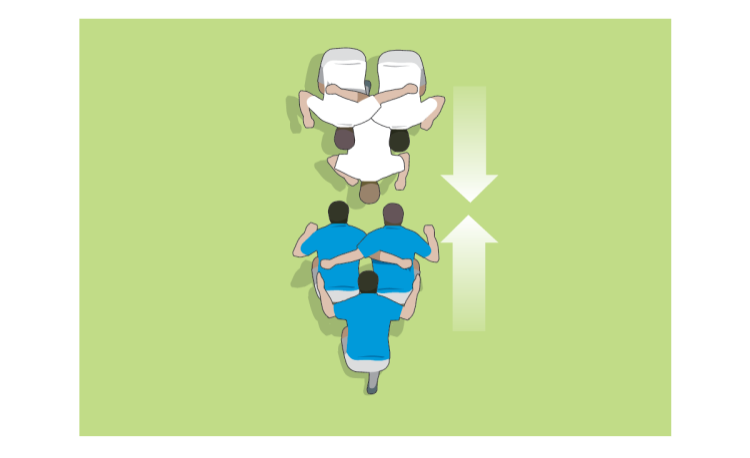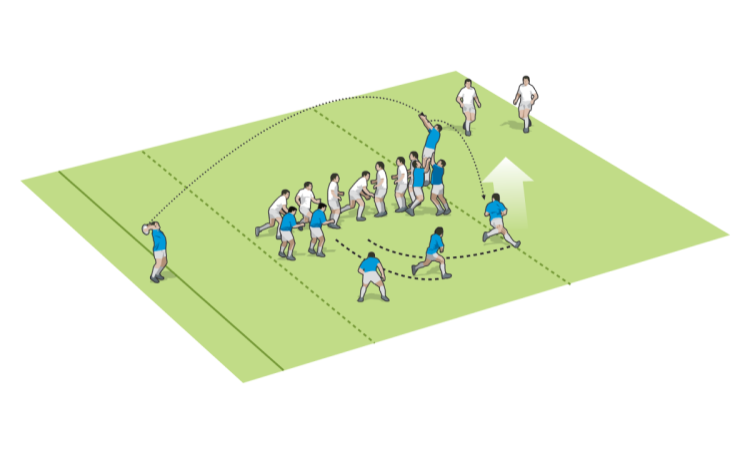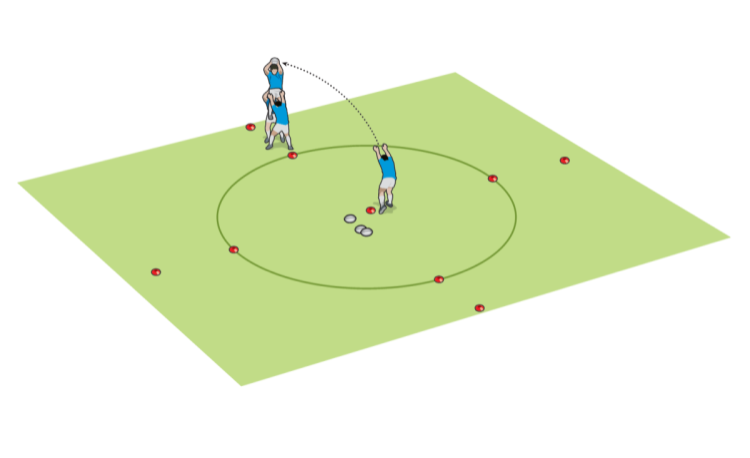You are viewing
1 of your 2 free articles
Attack with front ball
Scrums & Lineoutsby Joe Payton
Use the catch and drive, or the front peel to make the best use of front ball. The front peel is the perfect counter punch to a defence that sets up to defend a catch and drive.
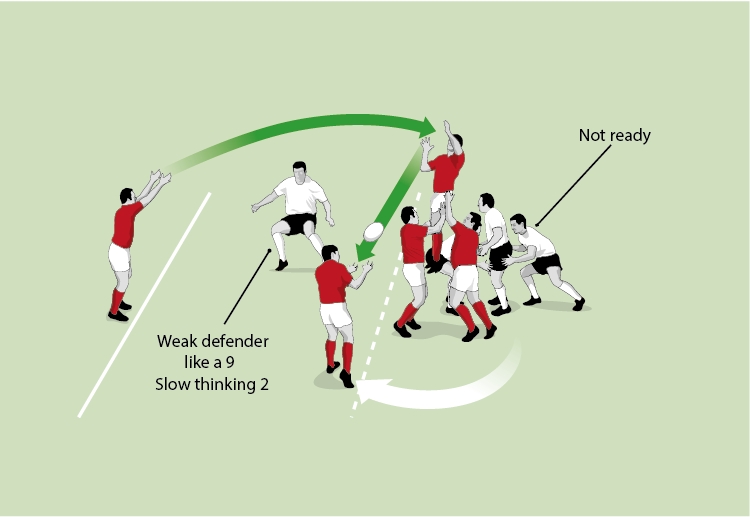
With a player taking the ball from the front jumper into the 5m channel, you can exploit a weak defender, such as a slow hooker or small 9. Works best if their front pod is slow getting into position because they are not ready.
Lineout ball which is taken from the front jumper and run into the 5m channel is called a “front peel”. Defensive teams have become more astute at defending this area but I still think they are a useful weapon.
To start a catch and drive, when the ball is brought down by the number two jumper in the line, the front and back lifter bind on and over the back of the jumper. Referees are now more likely to pick up the back lifter twisting around and becoming a shield between the opposition and jumper, so he has, like the front lifter, to bind square and in line with the jumper.
Bind over and body shape like a front row
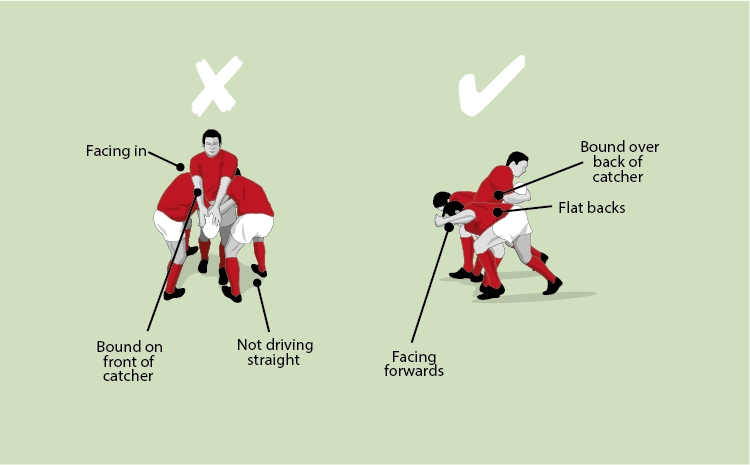
On the catch and drive, I think it is better to bind on the back of the jumper when he comes to the ground. And then take up a driving position like a front row would. Remember that the back lifter must not get in between the defenders and the jumper because referees are likely to penalise for obstruction.
These two lifters become the blocks. Their shape will be very much like that of a prop when scrummaging. They “fail” if they have been shifted out of position and allow the opposition to get through and attack the ball.
Basic catch and drive set up
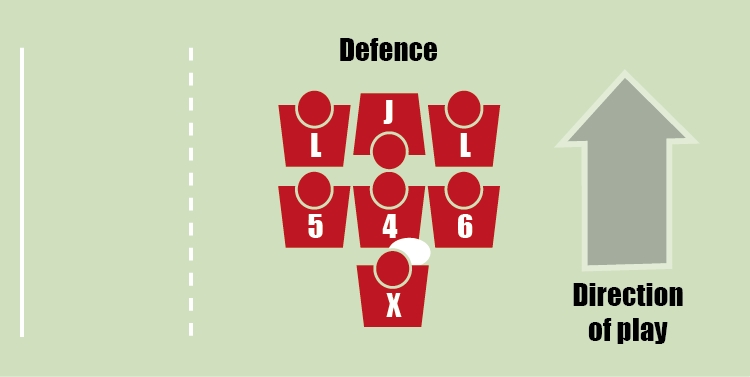
Form three rows, with the jumper (J) facing towards your try line and the lifters (L) binding his back. The next player rips the ball from the jumper, with the fifth and sixth player binding on him to form a second row. Finally have your “X-factor” player at the back. He can be a good runner like a hooker who can break and make metres if necessary.
Now we have our blocks in position, the fourth player in the lineout will come in to take the ball from the jumper. Timing must be correct as he needs to take the ball as the jumper lands to initiate the drive.
The new ball carrier will put the ball on his outside hip. Under the new laws, he should be able to shift the ball back through the maul and away from danger. Once the back player has taken the ball, he punches the maul forward to start some forward momentum. This is to give the opposition less time to set themselves to counter. Also, too much delay can make the referee call “use it”.
Since our fourth player is likely to be a lock or a lifter, I prefer the ball to eventually go backwards to the hooker or another explosive runner. Depending on what we want to do next, it might be that the 9 tells this player to attack the gain line.
The fifth and sixth player come into the make up the maul, so we have a row of three, followed by another row of three and perhaps the ball carrier at the back.

With a player taking the ball from the front jumper into the 5m channel, you can exploit a weak defender, such as a slow hooker or small 9. Works best if their front pod is slow getting into position because they are not ready.
FRONT PEEL
Lineout ball which is taken from the front jumper and run into the 5m channel is called a “front peel”. Defensive teams have become more astute at defending this area but I still think they are a useful weapon.
- It can be used effectively if you arrive at the lineout quickly and the ball is up and in before the opposition have a chance to set themselves.
- Some teams will defend with a hooker in the 5m channel, others with the 9. You can decide to target a “dull” hooker who tends to wander with the throw or a weak tackling 9.
- If teams are set for a catch and drive, you can attack the front edge of the lineout as they step into stop the perceived drive.
CATCH AND DRIVE
To start a catch and drive, when the ball is brought down by the number two jumper in the line, the front and back lifter bind on and over the back of the jumper. Referees are now more likely to pick up the back lifter twisting around and becoming a shield between the opposition and jumper, so he has, like the front lifter, to bind square and in line with the jumper.
Bind over and body shape like a front row

On the catch and drive, I think it is better to bind on the back of the jumper when he comes to the ground. And then take up a driving position like a front row would. Remember that the back lifter must not get in between the defenders and the jumper because referees are likely to penalise for obstruction.
These two lifters become the blocks. Their shape will be very much like that of a prop when scrummaging. They “fail” if they have been shifted out of position and allow the opposition to get through and attack the ball.
Basic catch and drive set up

Form three rows, with the jumper (J) facing towards your try line and the lifters (L) binding his back. The next player rips the ball from the jumper, with the fifth and sixth player binding on him to form a second row. Finally have your “X-factor” player at the back. He can be a good runner like a hooker who can break and make metres if necessary.
Now we have our blocks in position, the fourth player in the lineout will come in to take the ball from the jumper. Timing must be correct as he needs to take the ball as the jumper lands to initiate the drive.
The new ball carrier will put the ball on his outside hip. Under the new laws, he should be able to shift the ball back through the maul and away from danger. Once the back player has taken the ball, he punches the maul forward to start some forward momentum. This is to give the opposition less time to set themselves to counter. Also, too much delay can make the referee call “use it”.
Since our fourth player is likely to be a lock or a lifter, I prefer the ball to eventually go backwards to the hooker or another explosive runner. Depending on what we want to do next, it might be that the 9 tells this player to attack the gain line.
The fifth and sixth player come into the make up the maul, so we have a row of three, followed by another row of three and perhaps the ball carrier at the back.
Related Files
Vol-1-Issue-516-J-Payton-attack-with-front-ball.pdfPDF, 377 KB
Newsletter Sign Up
Coaches Testimonials

Gerald Kearney, Downtown Las Vegas Soccer Club

Paul Butler, Florida, USA

Rick Shields, Springboro, USA

Tony Green, Pierrefonds Titans, Quebec, Canada
Subscribe Today
Be a more effective, more successful rugby coach
In a recent survey 89% of subscribers said Rugby Coach Weekly makes them more confident, 91% said Rugby Coach Weekly makes them a more effective coach and 93% said Rugby Coach Weekly makes them more inspired.
Get Weekly Inspiration
All the latest techniques and approaches
Rugby Coach Weekly offers proven and easy to use rugby drills, coaching sessions, practice plans, small-sided games, warm-ups, training tips and advice.
We've been at the cutting edge of rugby coaching since we launched in 2005, creating resources for the grassroots youth coach, following best practice from around the world and insights from the professional game.
More from us
© 2023 Rugby Coach Weekly
Part of Green Star Media Ltd. Company number: 3008779
We use cookies so we can provide you with the best online experience. By continuing to browse this site you are agreeing to our use of cookies. Click on the banner to find out more.




